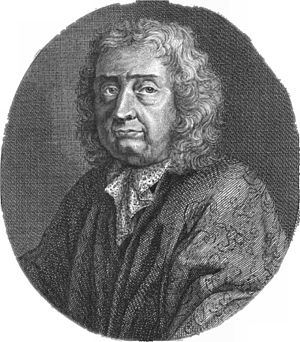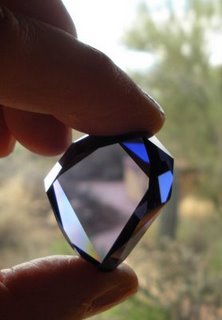 Image via Wikipedia
Image via WikipediaJean Baptiste Tavernier (1605-1689) was an extraordinary French traveler and gemstone merchant who spent forty years away from home, trading in gemstones mostly in faraway India.
He goes down in history as the man who brought the precursor of the Hope Diamond called the Tavernier Blue back to Europe. He also left for posterity a remarkable record of his voyages and his diamond expertise which was later translated as Travels in India.
Tavernier was born the son of a cartographer and engraver. His life long wanderlust had early roots in his childhood. He listened avidly to the men who visited his father on geographical matters and yearned to see the countries depicted in the maps.
At 27, he made a chance visit to Constantinople, a major trading center, and was instantly mesmerized by the exotic trade goods he saw especially the gemstones. He joined a caravan headed to Persia where he began his trading business. He returned to Paris and spent a year learning about gemstones from a jeweler.
 Hope Diamond at the Smithsonian by edgeplot via Flickr
Hope Diamond at the Smithsonian by edgeplot via FlickrEach of the subsequent 5 trips he made to India took 5-6 years. He constantly traded everywhere he went - he would sell gems he brought from Europe and buy other gems relatively cheaply in India. India was the only major source of diamonds in those days. He wrote, "The diamond is the most precious of all stones and is the article of trade to which I am most devoted." His devotion to diamonds was largely due the the huge profits he knew he would get for them back home.
 Tavernier in Oriental costume via WikipediaHe traveled at night if it was very hot and in style befitting a wealthy merchant. Depending on the state of the roads, he would either travel in his own carriage or wagon or have men carry his palanquin. His retinue of about 60 servants included the guards he needed to protect his goods.
Tavernier in Oriental costume via WikipediaHe traveled at night if it was very hot and in style befitting a wealthy merchant. Depending on the state of the roads, he would either travel in his own carriage or wagon or have men carry his palanquin. His retinue of about 60 servants included the guards he needed to protect his goods.He also learned how to keep his goods safe from marauding insects by keeping his storage chests in the middle of the room away from the walls. In severe hot weather (over 100 degrees F), he traveled at night. His hardy constitution made him a survivor at a time when many people succumbed to numerous diseases.
Tavernier meticulously recorded a lot about his journeys and was a keen observer. However, he was first and foremost a businessman and the only thing he really cared about was profit. So there were large gaps in his narrative. Nor was he a scholar who might have organized his notes in a more logical fashion.
Some of his customers in India were the Mogul and Hindu rulers and their families so he got to know them and their royal courts well. The Taj Mahal was completed in his lifetime and yet all he had to say about it was the staggering cost to build it and that it took 20,000 men 22 years to build. Nothing at all about the beauty of the architecture and setting!
He drew and described the Tavernier Blue as "un beau violet " (a beautiful violet) but failed to note exactly when he bought it! Historians think he bought it from the Kollur mine in the Kingdom of Golconda (Golkonda), some time between 1640 and 1667. In his day, the diamond output from the mines of Golconda was enormous. It was the most important of the 3 main diamond producing areas in India before they all petered out by the 18th century.
 Tavernier's original sketches of the Tavernier Blue via Wikipedia
Tavernier's original sketches of the Tavernier Blue via Wikipedia Cubic zirconia replica of the Tavernier Blue via Wikipedia
Cubic zirconia replica of the Tavernier Blue via WikipediaTrading in the days before credit cards and money transfers was done via money changers called shroff. Tavernier exchanged the various currencies he picked up on his travels for pagodas (small slabs of gold about the size of fingernails) from the money changers. He had to make sure he got brand new pagodas as the Kollur diamond merchants would not accept worn down old pagodas.
When dealing with money changers and local gem merchants, Tavernier had to figure out weight units as well as currency exchanges. Back then, there were no standardized carat systems in Europe. In most of India, they used ratis; a rati being the same as 7/8 of a carat. In Golconda, mangelins, about 1 3/8. He was something of a human calculator!
Buying large diamonds from the Golconda mines was also risky business as the ruler of the kingdom imposed harsh penalties if any diamonds over 10 carats was not reserved for his personal use. Somehow though the beautiful blue diamond escaped the ruler's spies at the mines and ended up being sold to Tavernier.
He bargained with the diamond merchant in a curious fashion. They sat across each other at a table and placed their hands under fabric sashes. Negotiations were made in silence by touching each other's fingers as they worked on an agreed price. A finger touch meant 100 pagodas whereas one at the knuckle denoted 50 pagodas. No one ever said out loud the price of a diamond.
Tavernier also managed to smuggle the large diamond past the Golconda officials. No doubt many rupees greased the way. When he returned from one of his voyages in 1668, his cargo included 3 million livres worth ($24 million today) of gems!!
In 1669, Tavernier sold the Tavernier Blue to King Louis XIV of France for 220,000 livres or the equivalent of 147 kgs worth of gold. A patent of nobility was also granted to Tavernier who then bought an estate for himself and his wife, the daughter of the jeweler who once trained him. He continued to travel even in old age and died on a trip to Russia when he was 84.
In 1678, Louis XIV's court jeweler was commanded to recut the 115 metric carat Tavernier Blue which resulted in a much smaller 69 carat diamond. It became known as the French Blue. It was first set as a huge royal cravat pin but later became the pendant jewel of the Order of the Golden Fleece.
 |
| Painting of the Order of the Golden Fleece via Wikipedia |
How do we know for sure the Tavernier Blue yielded the French Blue and in turn resulted in the Hope Diamond? The Smithsonian Institution carried out an extensive research project back in 2005 to establish this lineage via modern imaging and computer modeling technology. The historical data was examined and careful measurements of the Hope Diamond were also made.
The modeling study showed the Hope did come from the French Blue and before that, the Tavernier Blue. It also proved no sister stones could have been created during each recutting. The project also saw the creation of cubic zirconia replicas of the earlier stones.
One of the gem cutters involved in the project, Steve Attaway, said, “The geometric evidence was overwhelming, leading us to conclude that not only did the Hope Diamond fit within the French Blue Diamond, but some of the facets on the Hope Diamond may be relics from the French Blue Diamond.”
References
Marian Fowler(2002), Hope: Adventures of a Diamond
Smithsonian Institution (2005) Hope Diamond Press Release
Before You Go
- Of Karats, Carats and Carrots!
- Harry Winston and the Hope Diamond's 50th Anniversary at the Smithsonian
- Lady Nancy Astor and the Sancy Diamond
Original Post by THE BEADING GEM
Jewelry Making Tips - Jewelry Business Tips
Two days ago I was at the Smithsonian’s National History Museum in Washington, D.C. and saw the Hope diamond in it's new and temporary setting called "Embracing the Hope". Three rows of white diamonds surround the diamond and what I found the most interesting was the fact that the clasp for the new necklace is nearly invisible. I'm not sure how the clasp works. Also, the diamond is a lighter blue than what you see in the photos.
ReplyDeleteYou're very fortunate! I have yet to see the Hope diamond myself. That's very interesting about the clasp. Here is the post I wrote about the Embracing the Hope design which includes a picture of the front :
ReplyDeletehttp://www.beadinggem.com/2009/10/embracing-hope-is-new-hope-diamond.html
I love your historical jewelry posts! I saw the Hope Diamond at the Smithsonian years ago -- I live in northern Virginia, so I should really go take another look.
ReplyDelete